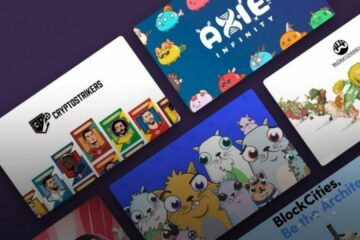NFTs are getting famous, and you have probably heard of them by now. They are very popular in the crypto world and are gaining popularity in other sectors as well.
Can you even believe a GIF file sold for $ 590,000 at auction? Now you might be wondering what that GIF file will contain. Well, it was simply the Nyan Cat NFT that brought so much wealth to the creator. Isn’t that shocking?
What if I tell you there’s more to it than that?
You’ll be shocked to hear that Beeple sold an NFT art for $ 69 million. That is the strength of NFT in this modern world.
Now let’s understand a little more about NFTs to get a better idea of them.
What are NFTs?
NFT (Non-Fungible Tokens) are a digital certificate of authenticity. In this day and age, NFTs are known to be the most popular things to do. NFTs can easily be understood as digital tokens that can include digital art, digital assets, music, videos or any other asset in the digital world that is based on blockchain technology.
If you ever go to an auction, you’ll see classic works of art, antiques, vinyl, first editions, and other historical items there. These articles are certified as authentic.
NFTs are created with a similar concept, but their existence takes place in the digital world. NFTs can accept any video, MP3, image, GIF or any other file format and certify it as unique. There used to be no technology for owning digital assets. You can now take ownership of your digital assets because of block chain technology.
You can collect, sell, buy or even destroy NFTs in the digital world. Blockchain technology logs every transaction you make, along with the price of that NFT, which is visible to everyone on the internet.
NFTs and games
When we talk about NFTs, the first thing people often associate it with is gaming. The best thing about NFTs is that you can change the digital ownership of any digital asset. So far we haven’t been able to own any digital assets.
Whenever players bought some in-game items, they considered them to be their own. In reality, they belonged to the game publishers. For example, if you own a large number of in-game objects in League of Legends and the publisher decides to quit the game, you will end up losing all of the digital assets.
Now the scenario has completely changed. The game developers do not have centralized control over Crypto Kitties and NFT collectibles as they are handled through smart contracts. Even if the game closes tomorrow, there is no problem transferring or selling your crypto kitties. That sounds amazing, doesn’t it?
In the past, the items in the game were never unique. With the concept of NFTs, you can now create articles with different properties and also give them a personal touch. Crypto kittens have strengthened the foundation of NFTs in the gaming world as well as other industries.
Well, not all is that good on the NFT side. This also entails certain challenges and risks. Let’s go through them one by one.
What are the challenges and risks with NFTs?
Non-fungible tokens make big money for digital creators. Many works of art are sold online every day. It is even possible for a creator to make millions in a matter of seconds when their NFT is sold in digital space. It is also visible that people are more likely to buy, sell and invest in the digital market than to do the same in the physical market.
This creates a significant risk of cyberattacks and online fraud. There is a high possibility that the digital assets and investors who buy and sell NFTs in the market will be damaged. While the NFT market has tremendous potential, there are certain risks to be considered.
If you are thinking about getting into the NFT market, understanding these risks and challenges in NFTs in order to have a better idea.
Risks of smart contracts and maintenance of NFTs
The risk of smart contracts and NFT maintenance is a prominent risk in the NFT market right now. There are several scenarios in which hackers attack a DeFi (Decentralized Finance) network and steal a large amount of crypto. Recently, the most famous DeFi protocol called Poly Network was attacked by hackers and $ 600 million was stolen in this NFT theft. The reason for this theft was that the security of smart contracts was insufficient.
The hackers successfully exploited the weaknesses of smart contracts to carry out such a large-scale attack on the Poly Network.
Evaluation challenges
The biggest challenge in the NFT market is the uncertainty in determining the NFT price. Well, the price of an NFT depends on the creativity, uniqueness, scarcity of buyers and owners, and much more. NFT prices fluctuate significantly as there is no set standard for any particular type of NFT.
People cannot determine the factors that could determine the price of NFT. As a result, price fluctuations remain constant and the valuation of NFT becomes a major challenge.
Legal challenges
There is no known legal definition of NFT anywhere in the world. Different countries such as the UK, Japan and the EU are proceeding with different approaches to classifying NFT. This makes it necessary to develop an international collection of non-fungible tokens for regulation setting and legalization around the world.
The NFT market has grown significantly so a regulator is essential. An enormous increase is evident in the use cases of NFTs. This now requires a regulator to adapt to the rules and regulations of NFTs.
The current laws regarding NFT are still in the process of getting the right definition for it. As the market and the variety of NFTs continue to grow, it becomes difficult to establish a solid foundation for NFT compliance.
Cyber threats and online fraud risks
The popularity of NFT has also increased the likelihood of cyber threats to the NFT market. There are many instances seen of replicas of the original NFT stores being posted on the Internet. These stores look authentic because of the original logo and content. These fake NFT stores pose a massive risk as they may sell NFTs that don’t even exist in the digital world. Additionally, there is a possibility that counterfeit NFTs could be sold in a counterfeit NFT shop.
Another risk is someone posing as a famous NFT artist and selling counterfeit NFTs. The risk of online fraud is enormous due to copyright theft, fake airdrops, fake NFT giveaways, and recreation of popular NFTs. Some people even advertise such giveaways on social media for more appeal. While promoting NFT, some people get scammed in such fake deals.
Intellectual property rights
Ownership of an NFT is another important issue to consider. When trying to buy an NFT in the market, it is important to find out whether or not the seller actually owns that NFT. There are scenarios where people pose as salespeople while only having replicas. Here you only get the right to use this NFT, but not the intellectual property rights.
If you go through the metadata of the smart contract, you can find the terms of ownership of that NFT. There should be a rule that the artists are only allowed to view NFTs that they own. It is not possible to associate NFT marketplaces with traditional property rights. New intellectual property rights need to be taken into account, such as publication rights, trademarks, copyrights and moral rights for decentralized blockchain technology.
Challenge to view NFTs as securities
Several people are considering purchasing NFTs as securities. The chairman of the SEC (Securities and Exchange Commission) stated that most NFTs in the market are sold as securities. But in reality, the Supreme Court has only linked NFTs to investment contracts. Well, this is a huge risk for NFT. In order to qualify as securities, NFTs must pass certain parameters of the Howey Test.



0 Comments